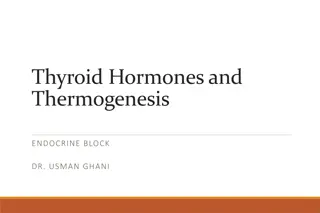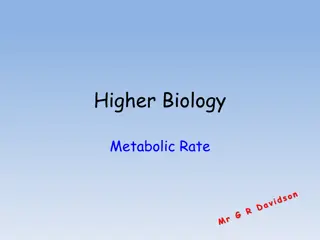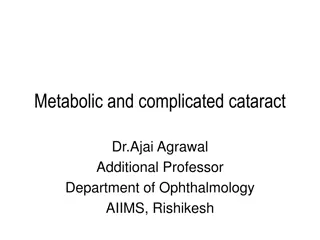Metabolic bone disease
Understand the metabolism of calcium and phosphorus, common disturbances, and nutrient requirements in preterm infants. Learn why metabolic bone disease is important and its long-term effects on bone health.
1 views • 59 slides
Understanding Steatotic Liver Disease: Importance, Epidemiology, and Pathology
Steatotic liver disease, including metabolic dysfunction associated steatohepatitis (MASLD) and metabolic associated alcoholic liver disease (MALD), is a common cause of liver test abnormalities in the United States. Risk factors such as obesity and metabolic syndrome can lead to advanced fibrosis a
2 views • 44 slides
Electrolyte and Metabolic Disturbances in the Critically Ill
Dr. Srilekha Ammapalli discusses the cations (sodium, potassium, calcium, magnesium) and anions (chloride, bicarbonate, phosphate, lactate) involved in electrolyte and metabolic disturbances in critically ill patients. The physiology, causes of abnormalities, diagnosis, evaluation, and management of
2 views • 104 slides
Diabetic Ketoacidosis: Understanding Metabolic Acidosis in Diabetes
Explore a case study on diabetic ketoacidosis to understand the basis of metabolic acidosis in type 1 diabetes mellitus, differentiate between type 1 and type 2 diabetes, predict blood buffer equilibrium changes, apply Winter's formula, correlate clinical data with biochemical tests, explain insulin
3 views • 34 slides
Understanding the Role of Phosphatase Enzymes in Metabolic Reactions
Phosphatase enzymes play a crucial role in various metabolic processes by releasing phosphate groups, increasing their availability for energy synthesis and cell structure formation. Acid phosphatases, with an optimum pH below 7.0, can be extracted from plant tissues like germinating mung beans. A p
7 views • 34 slides
Overview of Glucose Metabolic Pathways in Clinical Chemistry
Explore the major metabolic pathways of glucose, including glycogenolysis, gluconeogenesis, glycolysis, and more. Understand the production, utilization, catabolic, and anabolic cycles of glucose in cellular metabolism. Learn about key concepts such as hexose interconversion, HMP/PPP, Krebs cycle, a
4 views • 29 slides
Regulation of Energy Homeostasis by AMPK System and Its Modulation Factors
The AMPK system plays a crucial role in regulating energy homeostasis by sensing the cellular AMP:ATP ratio and responding to metabolic stresses that affect ATP production or consumption. AMPK is activated by factors such as hypoxia, glucose deprivation, and metabolic inhibitors, as well as by compo
0 views • 27 slides
What is #ScienceSaves?
The #ScienceSaves campaign promotes the impact of science on improving lives and health. Dr. Patricia Bath, a renowned ophthalmologist, contributed greatly to eye health by innovating eye surgery techniques, ultimately preventing blindness. Explore the fascinating world of the human eye, its structu
0 views • 15 slides
Techniques for Investigating Plant Metabolic Pathways and Biogenetic Studies
This content explores various techniques used in pharmacognosy and phytochemistry to investigate the metabolic pathways in plants and study the formation of primary and secondary metabolites. Methods such as utilizing radioactive isotopes, tracer techniques, isolated organs/tissues, grafting, and mu
4 views • 12 slides
Understanding Acid-Base Balance in Health and Disease
Many critical illnesses can disrupt acid-base balance, indicating underlying diseases or organ damage. Interpretation of disturbances requires analyzing arterial blood gases, plasma electrolytes, and compensatory mechanisms. Acid-base disorders are classified into respiratory acidosis, respiratory a
3 views • 26 slides
Managing Nutritional and Metabolic Diseases in Zoo and Wild Animals
The prevention, control, and treatment of nutritional and metabolic diseases in zoo and wild animals are essential for maintaining their health. These diseases, such as rickets, osteoporosis, osteomalacia, and fibrous osteodystrophy, can result from imbalances in dietary nutrients and metabolic dera
0 views • 10 slides
Abomasal Displacement in Veterinary Medicine
Abomasal displacement refers to the movement of the abomasum, a wandering organ in cattle due to loose attachments. This condition can lead to left or right displacement, as well as torsion or volvulus. Various factors such as feeding high concentrate rations, metabolic alkalosis, and other metaboli
0 views • 27 slides
Understanding Metabolic Control Mechanisms in Cellular Regulation
Metabolic control mechanisms play a crucial role in maintaining homeostasis within cells by regulating metabolic pathways. This involves finely adjusting the output of pathways in response to external signals, ensuring the proper flux of metabolites to meet cellular needs. Pacemaker enzymes, such as
1 views • 17 slides
Understanding Thyroid Hormones: Biosynthesis, Functions, and Clinical Implications
This educational material delves into the types and biosynthesis of thyroid hormones, the physiological actions of thyroid hormones, regulation levels, thyroid function tests, goiter, and the distinction between hypo- and hyperthyroidism. It covers the role of thyroid hormones in thermogenesis, meta
0 views • 33 slides
Understanding Cutaneous Circulation and Blood Supply in Different Body Regions
Cutaneous circulation plays a vital role in supplying blood to the skin, with variations in apical and non-apical regions of the body. The blood flow is regulated by neural, thermal, and metabolic factors, and controlled by sympathetic fibers. Sympathetic vasoconstriction and vasodilation affect the
0 views • 19 slides
Importance of Nutrition in Patient Healing and Recovery
Gain insight into the critical role of nutrition in aiding patients in their recovery from injuries and enhancing their physical well-being post-injury. Explore the phases of injury, the physiological and metabolic impacts of each phase, and the corresponding nutritional support strategies. Delve in
1 views • 49 slides
Diagnosis Criteria for Perinatal Asphyxia
Perinatal asphyxia refers to the interruption of oxygen supply to the fetus or newborn, leading to metabolic consequences and potential multiorgan dysfunction and long-term neurological issues. The American Academy of Pediatrics (AAP) and the American College of Obstetrics and Gynecology (ACOG) have
0 views • 12 slides
Overview of Glycine Metabolism and Its Importance in the Body
Glycine, the simplest amino acid, plays a crucial role in various metabolic pathways in the body. It can be converted to important compounds like pyruvic acid, lactic acid, and creates the one-carbon pool. Glycine is essential for heme synthesis, glutathione formation, purine synthesis, and more. In
8 views • 19 slides
Understanding Inborn Errors of Metabolism and Metabolic Disorders
Inborn Errors of Metabolism (IEM) are genetic disorders that disrupt metabolic pathways, leading to substrate accumulation or product deficiency. These disorders can be classified based on toxic accumulation, protein metabolism, carbohydrate intolerance, lysosomal storage issues, energy production d
0 views • 29 slides
Understanding Astigmatism and Its Types
Astigmatism is a common refractive error where light entering the eye fails to focus on the retina, resulting in blurred vision. This condition is characterized by variations in the shape of the cornea or lens, leading to disturbances in vision. There are two types of astigmatism: regular and irregu
4 views • 33 slides
Understanding Basal Metabolic Rate and Energy Balance
Energy is essential for various bodily functions, with Basal Metabolic Rate (BMR) representing the energy needed to sustain internal organ activity and body temperature. Kilocalories from food play a crucial role, and maintaining an energy balance is key for overall health. Factors like exercise, ho
5 views • 16 slides
Insights into Hibernation in Animals: Functions and Varieties
Hibernation is a fascinating biological phenomenon observed in various animals, enabling them to survive harsh conditions by conserving energy. This state of inactivity and metabolic depression is crucial for species like bears, pygmy possums, and bats during winter months. Animals hibernate to cope
0 views • 15 slides
Understanding New Jersey Mature Driver Challenges
New Jersey has a significant population of mature drivers aged 65 and older, accounting for 21% of licensed drivers. The proportion of crashes involving mature drivers has increased, with over 17% occurring in 2020. Vision, hearing, cognition, and physical condition changes with aging impact driving
0 views • 51 slides
Understanding Eye Health: From Anatomy to Treatment of Common Eye Conditions
Explore the anatomy of the eye, learn about common eye diseases like corneal laceration and cataracts, and understand their treatments. Discover the impact of cataracts on global blindness and the surgical options available for restoring vision. Follow a martial arts athlete's journey through cornea
0 views • 13 slides
Understanding Cataracts: Causes, Effects, and Treatment
Cataract is a common eye condition characterized by clouding of the lens, leading to gradual vision loss. It is the third leading cause of preventable blindness and is typically treated with surgery. Various factors, such as aging, trauma, and toxic exposures, contribute to the development of catara
0 views • 34 slides
Importance of Proper Sleeping for Metabolic Balance and Obesity
Proper sleeping plays a crucial role in metabolic balance and obesity prevention. Studies show that both short and long durations of sleep are associated with an increased risk of mortality and obesity in both children and adults. Sleep deprivation can lead to a higher intake of sweet and dessert fo
0 views • 14 slides
Multidimensional Optimality of Microbial Metabolism
Exploring the multidimensional optimality of microbial metabolism through metabolic network analysis, C-based flux analysis, and stoichiometric reaction modeling. The concept of Pareto optimal solutions in multi-objective optimization problems is discussed in the context of microbial metabolic pathw
0 views • 22 slides
Insights into Cardiac Research: Metabolic Syndrome and Acute Myocardial Infarction Studies
Explore the latest findings in cardiac research focusing on two critical clinical problems: Metabolic Syndrome (MetS) and Acute Myocardial Infarction. The studies involve human clinical data, blood sampling, adipose tissue biopsies, cell culture studies, thrombus aspiration, gene arrays, and regulat
0 views • 41 slides
Understanding Metabolic Rate in Biology: Measurement and Importance
Metabolic rate, the energy consumed by an organism in a specific time period, can be measured through heat energy, oxygen consumption, and carbon dioxide release. Various tools like calorimeters and respirometers are used for this purpose. The delivery of oxygen through efficient transport systems i
0 views • 28 slides
Understanding Metabolic and Complicated Cataracts: Classification and Subtypes
Explore the etiological classification of cataracts, focusing on metabolic and complicated types such as diabetic cataracts, galactosemia-related cataracts, myotonic dystrophy-related cataracts, and hypocalcaemic cataracts. Learn about distinct morphological subtypes, pathophysiology, and specific c
0 views • 31 slides
Metabolic and Mechanical Cost of Sedentary and Physical Activities in Obese Children and Adolescents
A study by Stefano Lazzer, Grace O. Malley, and Michel Vermorel explores the metabolic and mechanical costs of sedentary and physical activities in obese children and adolescents. The research delves into the main components of daily energy expenditure, the contribution of organs and tissues to body
0 views • 12 slides
Dr. Zoidis Evangelos: Endocrinology & Metabolic Syndrome Expert at Agricultural University of Athens
Dr. Zoidis Evangelos is a distinguished professional in the field of endocrinology and metabolic syndrome, currently serving as a Lecturer at the Agricultural University of Athens. With a background in biochemistry and extensive research experience, his work focuses on nutritional physiology, molecu
0 views • 12 slides
Optimizing Brain Health through Metabolic Tune-Up: A Case-Based Review
Explore the case of a 48-year-old RN facing various health challenges like depression, anxiety, obesity, diabetes, and more. Learn about core metabolic imbalances impacting brain health, personalized lifestyle medicine strategies, and the importance of addressing root causes for a balanced metabolic
0 views • 30 slides
Understanding Myopia Control for Optometrists
Myopia, or nearsightedness, is a growing concern with increasing prevalence, especially among younger populations in Asia. Genetics, environmental factors like prolonged digital device use, and lack of outdoor activities contribute to its development. Controlling myopia is crucial to prevent risks l
0 views • 23 slides
Understanding the Role of Gut Bacteria in Obesity and Metabolic Disease
Trillions of bacteria in our gut play a crucial role in obesity and metabolic diseases. By analyzing studies on antibiotic effects, bacterial composition, and diet impact, we learn how gut bacteria influence weight gain, energy use, and overall health. Research shows diverse bacterial types affect w
0 views • 16 slides
Understanding Metabolic Rate Measurement Techniques
Metabolic rate, the amount of energy used by the body over time, can be measured in different ways using respirometers and calorimeters. Respirometers measure oxygen uptake, while calorimeters calculate metabolic rate based on heat generated by the organism. Understanding these techniques is essenti
0 views • 13 slides
Understanding Metabolic Interaction in Society
In a capitalist society, metabolic interactions and exchanges are influenced by one's income and occupation quality. This separation between human existence and nature is emphasized in the relation between wage labor and capital. Marx's writings highlight how labor is essential for the metabolic int
0 views • 6 slides
Understanding Cataracts: Types, Causes, and Classification
Cataracts are characterized by lens opacity and can result from various factors like aging, trauma, or congenital issues. They are classified based on etiology and morphology, with distinct clinical types presenting different symptoms and characteristics.
0 views • 48 slides
Cardio-metabolic Abnormalities Among Normal Weight Individuals: A Cross-sectional Analysis of Race/Ethnicity in the U.S.
Overweight and obesity are known cardio-metabolic risk factors, but this study delves into abnormalities among normal-weight individuals. The research compares data from MESA and MASALA studies, including diverse race/ethnicity groups like White, African American, Hispanic American, Chinese American
1 views • 23 slides
National Programme for Control of Blindness & Visual Impairment Overview
The National Programme for Control of Blindness & Visual Impairment (NPCBVI) is a government initiative aimed at reducing the prevalence of avoidable blindness in India. Launched in 1976, the program focuses on providing comprehensive eye care services, developing human resources, enhancing communit
9 views • 15 slides







































